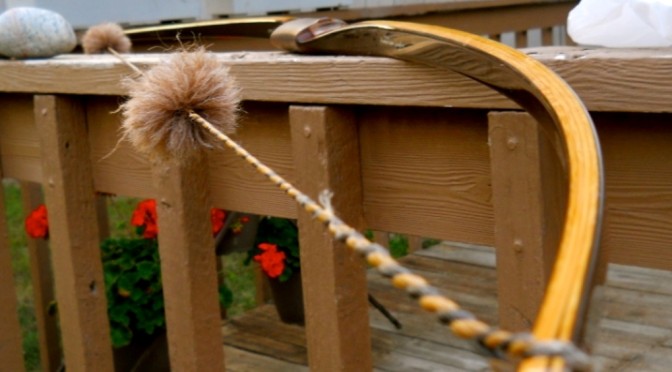While I intended on finishing our broadhead conversation in this post, a discussion with a fellow bowhunter and aspiring traditionalist immediately threw me off course. He had just picked up a beautiful, vintage, fiberglass, Browning recurve and wanted to know if he could shoot vanes instead of feathers from it. He was an all-season, all-weather hunter and noticed that his feathers didn’t hold up well in those conditions. Plus, the majority of his arrows already had vanes on them and he didn’t feel like switching.
[Tweet “Many of us have so little time away from work and family to be afield…”]
As miserable as bowhunting can be in wet conditions, there are many of us who go anyway. We can’t stand to see an opportunity whisked away by a little weather, especially when so many of us have so little time away from work and family to be afield. Time spent in the woods with the bow is sacred and we won’t waste a minute of it on the couch. If you feel the same, you’ll have to keep your tackle dry.
- Fletch covers – a solid option but having to remove them when you want an arrow is a hassle. I find they get snagged when moving within heavy brush and can be pulled off easily.
- A plastic bag and a rubber band – the Fred Bear way and cheaper than a fletch cover, but plastic bags are loud and you are dealing with the same issues as above.
- Powders and chemicals – I’ve found this method fascinating, but depressingly ineffective. Anything you rub into your feathers will either stiffen them or shake off. It isn’t worth the trouble.
- Enclosed quiver styles – The best option I’ve found thus far. Quivers like the Rancho Safari Catquiver will keep your fletching dry as long as your arrows are inside. Unfortunately…they have to be inside.
So, what about vanes?
While not ideal, vanes can indeed be shot out of recurves or longbows with an “elevated” rest, which is basically anything that keeps the arrow and fletching from making contact with the bow. Vanes are rigid and do not collapse when passing through the riser like feathers do, thus as little surface area as possible is required to keep the arrow flying properly.
[Tweet “Vanes can indeed be shot out of recurves or longbows.”]
There are a variety of elevated rests to choose from, but I recommend a stick-on flipper rest or brush rest. Both are cheap and work fine. You can also make one out of a piece of thin leather and a toothbrush. My Dad uses toothbrush rests like these on all of his bows and they hold an arrow much better than the other styles do.
Making them is easy and cheap. Simply check out the tutorial that Mark Kimber wrote for Traditional Bowhunter magazine. It’s the same tutorial Dad followed and is extremely helpful.
Once installed, a little tuning will be required to get your arrows flying correctly. While doing so, it is imperative your fletching is rotated so the inside-most vane is pointed at a downward angle and running down the crease of your bow’s shelf where the site-window meets the rest. This will ensure the vanes are making as little contact with the bow as possible. I would also recommend you choose a very short vane. The less vane passing through the riser: the better. Pour weather conditions will limit the effective range of your bow anyway. I personally wouldn’t take a shot over 12 yards in poor conditions and you don’t need a lot of fletching to get good flight at that range. A well-tuned, un-fletched arrow will fly fine at that range, but it is necessary to have something to guide the arrow when a broadhead is mounted, as they tend to plane a bit.
In conclusion, we are talking about making the best of a poor situation. I would personally never advocate the use of vanes on any stickbow and know few that actually use them. Traditional bows were meant to shoot feathered arrows. It is a combo that has been effective since the invention of the weapon and there is no reason to change. It is also important to note that if you plan on hunting with vanes, you should practice with vanes – something most archers do not enjoy on a daily basis.
Better to just cover your feathers and keep them shootable!
Discover more from The HuntFishTravel Show
Subscribe to get the latest posts sent to your email.




There are some high speed videos of different spine strength arrows being shot off of longbows to demonstrate the effect of arrow flex on accuracy. Do you know if anything similar has been done to compare different fletching materials and their contact and effect with the bow?
I’m sure they exist, but I would consult with the experts on YouTube. The only proof I have is the experiences of others and myself. You can get serviceable flight from vanes, but they aren’t comparable to feathers. Some compound shooters still shoot feathers because they believe the same thing. More would if it wasn’t such a hassle. It’s much easier to just EZ Wrap your vanes on these days and vanes last a whole lot longer. Fletching arrows is half the fun for most trad guys, so we don’t mind if our arrows get a little ratty. I shot in the rain all last weekend with my father and can tell you that he had much better arrow flight with his elevated toothbrush rests than I did off the shelf once rain became a factor. On that note, many do not believe that elevated rests are “traditional”. Seems silly to me as people have been using them for decades.